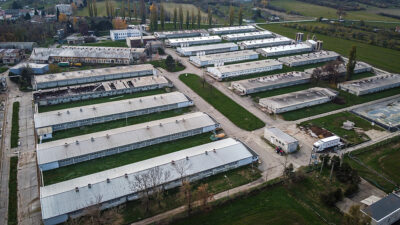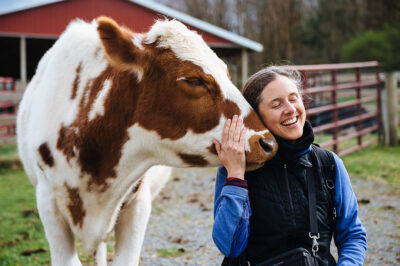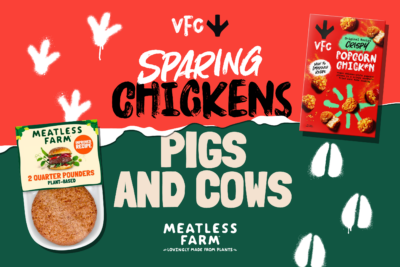Discussions about how to reduce greenhouse gas emissions, mitigate climate change, reduce pollution, use less water, and protect biodiversity often fail to consider one key contributor to all of these issues: factory farms. In addition to the suffering that animals endure during their time in the industrial machines that are factory farms, this way of farming is also terrible for virtually every aspect of the environment. Factory farms are major contributors to deforestation, greenhouse gas emissions, chemical runoff into waterways, and species extinctions, and they are even bad for the rural communities they supposedly support.
1. AIR POLLUTION
Air pollution is often attributed to familiar sources like exhaust pipes and burning coal. Agriculture is often underestimated when it comes to the devastating toll that it has on the air we breathe. This air pollution directly contributes to human deaths. A recent study concluded that nearly 13,000 people a year die in the U.S. from air pollution caused by animal agriculture. By comparison, vegetables grown for human consumption have a negligible impact.
Agriculture as a whole is responsible for a significant portion of human greenhouse gas emissions, with one reputable estimate putting the figure at 26 percent. Within this, the contribution of animal agriculture is particularly severe, accounting for over half of that total. A lot of the greenhouse gas emissions from the production of beef, chicken, and other animal-derived foods consist of methane and nitrous oxide, which are both considerably more toxic than carbon dioxide.
2. WATER POLLUTION
The average cow produces about 12 tons of manure every year. Some factory farms have hundreds or even thousands of cattle all housed in very tight quarters producing a staggering amount of waste. Much of the waste from these farms, and those raising other animals, ends up making its way into waterways with devastating consequences. Recent analysis found that the water in areas with high concentrations of factory farms contained superbugs that could be dangerous to human health, including antibiotic-resistant strains of E coli.
3. GLOBAL WARMING
Factory farming contributes to global warming both by emitting greenhouse gases and by destroying the natural resources that sequester carbon. Up until 2021, the Amazon rainforest acted as a carbon sink, capturing vast amounts of carbon dioxide from the atmosphere. In 2021, scientists found that for the first time the rainforest was emitting more carbon than it stored. The major cause? Fires being purposefully lit to clear away the trees to make agricultural land to support cattle ranching. The damage being done to the forest is having an impact on the entire ecosystem, as now the areas near those being burned are also emitting more carbon than they hold.
4. DEFORESTATION
On average, 5m hectares of land is deforested every year. An incredible 41 percent of this is the result of beef production. While a lot of the destruction is to create space for grazing, land is also cleared to grow the crops that animals on factory farms consume. Oilseeds such as palm oil and soy account for the destruction of 18.4 percent of deforestation. Most soy (77 percent) is used to feed animals.
5. WATER USE
Despite the vast oceans that cover most of the planet, water, specifically fresh water, is a limited resource, and factory farms use a lot of it. Estimates suggest that animal agriculture is responsible for 20 percent of global fresh water usage.
6. WILDLIFE AND BIODIVERSITY
Recently, researchers found that the mass of all wild animals on the planet was dwarfed by the number of animals being raised for food. Though this fact may come as an unwelcome surprise for some, the reality is that the dangers of industrialised agriculture for biodiversity and wildlife have long been known.
7. OCEANS AND FISHERIES
In addition to the waste that makes its way into the oceans from factory farms on land, the last several years have seen the emergence of large-scale floating farms that raise fish. While industrial fishing is crippling wild fish populations, fish farms come with their own set of risks, notably the opportunity for feed, waste, parasites and diseases, and the antibiotics given to the farmed fish to pass out of the farms and into the surrounding waters, where they can wreak havoc on native species.
8. RURAL COMMUNITIES
The big players in animal agriculture often try to bill themselves as having a vital, positive role when it comes to rural development. As people from the midwestern United States can attest, the farms don’t bring prosperity but rather acrid air and plummeting property values. Poor public health, limited economic opportunities, and dwindling social support often cause people who once called rural communities home to move elsewhere in search of a better life.
HOW ARE FACTORY FARMS AFFECTING THE ENVIRONMENT?
Despite being characterised by taking up a relatively small area of land themselves, the environmental impacts of factory farms are wide. The facilities result in a staggering amount of waste, use large amounts of water, require vast swathes of land for growing animal feed crops, and cause large amounts of air and water pollution.
LAND USE AND DEFORESTATION
Just under half of all arable land is dedicated to agriculture. Of that, 77 percent is dedicated to animal agriculture. Much of the land being used to produce animal products was once forested. Beef production alone is responsible for 41 percent of global deforestation.
FRESHWATER USE
In addition to the heavy water usage of animal agriculture, industrial farming is also responsible for much of the pollution that can be found in waterways all across England. In the Wye catchment area that has recently seen a large increase in pollution, poultry farming is the largest culprit, responsible for 42 percent of the phosphorus researchers found. Cattle and sheep, however, were not far behind at 27 and 28 percent respectively.
THE MYTH OF CLIMATE-FRIENDLY CHICKEN
Discussions of greenhouse gas emissions from animal agriculture usually centre around cattle. While it’s true that the impact of cattle is particularly devastating, other animals raised for food also contribute heavily to climate change. A serving of chicken causes 11 times more greenhouse gases than one of beans. On top of these emissions, raising chickens on a factory farm also contributes significantly to water pollution.
GREENHOUSE GAS EMISSIONS
Raising animals for food is a major contributor to greenhouse gas emissions. So much so that phasing out the industry over 15 years would provide 52 percent of the reductions needed to limit global warming to 2C above pre-industrial averages and likely prevent truly catastrophic climate change.
ZOONOTIC DISEASES
Factory farms provide an ideal environment for the proliferation of zoonotic diseases. Deforestation and housing animals in or near their waste both contribute to the risk of disease transmission from humans to people. Replacing beef consumption with chicken has been suggested as a way of curbing greenhouse gas emissions, but this approach fails to adequately address the excessively high disease transmission risk associated with intensively farming chickens.
PESTICIDES
Pesticides are heavily used on crops grown for animal feed, such as corn and soy. One analysis found that 235m pounds of herbicides and insecticides were applied to corn and soy fields in the United States in just one year. The chemicals applied have been linked to a range of health issues, including cancer.
ANTIMICROBIAL RESISTANCE
Antibiotics are an important tool used to treat disease in both humans and animals. On factory farms, the essential medications are not just used to treat sick patients but are given to animals showing no signs of disease as a preventative measure. Already more than a million people are dying every year due to antibiotic resistance. Though in some places, including the EU, measures are being taken to combat the use of antibiotics in agriculture, their use within the industry is expected to continue to grow by 8 percent between 2020 and 2030.
FACTS ABOUT FACTORY FARMS AND THE ENVIRONMENT
- In the UK, 80 percent of all farmed animals live on factory farms.
- Manure contains both nitrous oxide and methane. The former has 265 times greater warming potential than carbon dioxide over a 100-year timescale, while methane has 28 times higher potential.
- Transitioning fully away from animal agriculture would provide a 30-year pause in net greenhouse gas emissions, providing enough time for a shift away from dependence on fossil fuels.
- Overuse of antibiotics, transport, multi-species farms, and genetically similar populations all contribute to the risk of zoonotic disease transmission.
CONCLUSION
One might think that given the sheer amount of damage being done to the environment by animal agriculture, we must rely on it for most of our nutrients. That simply isn’t true, in fact only 18 percent of global calories and 37 percent of protein come from animal products. The rest is derived from plant-based foods.
The reasons to switch to a vegan diet only get more pressing. As the options available to replace the animal products we once depended upon become more varied, making the swap continues to get easier.





